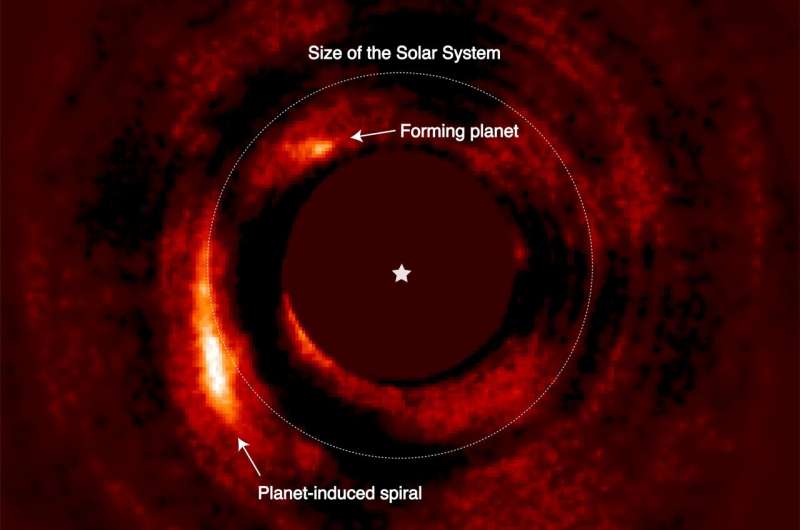This article has been reviewed according to Science X's editorial process and policies. Editors have highlighted the following attributes while ensuring the content's credibility:
fact-checked
peer-reviewed publication
trusted source
proofread
Researchers confirm the existence of HD 169142 b, the third protoplanet confirmed to date

An international team of researchers from the University of Liège (Belgium) and Monash University (Australia) has just published the results of the analysis of data from the SPHERE instrument of the European Southern Observatory (ESO), which confirms a new protoplanet. This result was made possible by advanced image processing tools developed by the PSILab of the University of Liège.
The study is published in the Monthly Notices of the Royal Astronomical Society: Letters.
Planets form from clumps of material in disks surrounding newborn stars. When the planet is still forming, i.e., when it is still gathering material, it is called a protoplanet. To date, only two protoplanets had been unambiguously identified as such, PDS 70 b and c, both orbiting the star PDS 70. This number has now been increased to three, with the discovery and confirmation of a protoplanet in the disk of gas and dust surrounding HD 169142, a star 374 light years from our solar system.
"We used observations from the SPHERE instrument of the European Southern Observatory's (ESO) Very Large Telescope (VLT) obtained on the star HD 169142, which was observed several times between 2015 and 2019," explains Iain Hammond, a researcher at Monash University (Australia) who studied at ULiège as part of his doctoral thesis.
"As we expect planets to be hot when they form, the telescope took infrared images of HD 169142 to look for the thermal signature of their formation. With these data, we were able to confirm the presence of a planet, HD 169142 b, about 37 AU (37 astronomical units, or 37 times the distance from the Earth to the Sun) from its star—slightly further than the orbit of Neptune."
Back in 2019, a team of researchers led by R. Gratton had previously hypothesized that a compact source seen in their images could trace a protoplanet. The new study confirms this hypothesis through both a re-analysis of the data used in their study as well as the inclusion of new observations of better quality.
The different images, obtained with VLT's SPHERE instrument between 2015 and 2019, reveal a compact source that is moving over time as expected for a planet orbiting at 37 astronomical units from its star. All data sets obtained with the SPHERE instrument were analyzed with state-of-the-art image processing tools developed by the PSILab team at the University of Liège.
"The last data set considered in our study, obtained in 2019, is crucial for the confirmation of the planet's motion," explains Valentin Christiaens, researcher at the PSILab of the University of Liège. "This data set had not been published until now."
The new images also confirm that the planet must have carved an annular gap in the disk—as predicted by the models. This gap is clearly visible in polarized light observations of the disk. "In the infrared, we can also see a spiral arm in the disk, caused by the planet and visible in its wake, suggesting that other protoplanetary disks containing spirals may also harbor yet undiscovered planets," says Hammond.
The polarized light images, as well as the infrared spectrum measured by the research team, further indicate that the planet is buried in a significant amount of dust that it has accreted from the protoplanetary disk. This dust could be in the form of a circumplanetary disk, a small disk that forms around the planet itself, which in turn could form moons. This important discovery demonstrates that the detection of planets by direct imaging is possible even at a very early stage of their formation.
"There have been many false positives among the detections of planets in formation over the last ten years," says Valentin Christiaens. "Apart from the protoplanets of the PDS 70 system, the status of the other candidates is still hotly debated in the scientific community. The protoplanet HD 169142 b seems to have different properties to the protoplanets of the PDS 70 system, which is very interesting. It seems that we have captured it at a younger stage of its formation and evolution, as it is still completely buried in or surrounded by a lot of dust."
Given the very small number of confirmed forming planets to date, the discovery of this source and its follow-up should give us a better understanding of how planets, and in particular giant planets such as Jupiter, are formed.
Further characterization of the protoplanet and independent confirmation could be obtained through future observations with the James Webb Space Telescope (JWST). The high sensitivity of JWST to infrared light should indeed allow researchers to detect thermal emission from the hot dust around the planet.
More information: Iain Hammond et al, Confirmation and Keplerian motion of the gap-carving protoplanet HD 169142 b, Monthly Notices of the Royal Astronomical Society: Letters (2023). DOI: 10.1093/mnrasl/slad027
Journal information: Monthly Notices of the Royal Astronomical Society Letters
Provided by University de Liege




















